 |
||
|
||
| ||
 CONTENTS
The fall that seized the Europe is now handing it in to the winter. The earth is still conquering the white attack, but soon it will surrender. Pockets of potential buyers of hi-end accelerators are also resisting losing their weight and tremble at the thought of the upcoming NV30, and ATI is said to be preparing something new able to stand against the future 3D king. Although the potential of High-End accelerators are intersting for many, not everyone can afford such card, and there are also quite wealthy people who assume that it's insane to spend $400-500 for a video card and it's better to get a gaming console with a decent bunch of games. There are not more than 5-6% of users out there who might buy such an expensive card, while the most will go with solutions priced at $80-100. Therefore, we'd better to have a look at new-comers from this price niche. Some of them were already reviewed, they are NVIDIA GeForce4 MX and ATI RADEON 9000 (Pro) based cards. But there is another long-liver on the market, - Xabre and, in particular, Xabre400, from SiS. Theoretical materials and reviews of video cards which concern functional
properties of the The companies the cards are coming from are well known to all of you, that is why we are heading directly into the analyses of the products. CardsThe cards have AGP x2/x4/x8 interface, two come with 64 MB and the Chaintech's and C.P.Technology's solutions come with 128 MB DDR SDRAM located in 8 chips on both PCB sides. |
| Inno3D Xabre400 | |
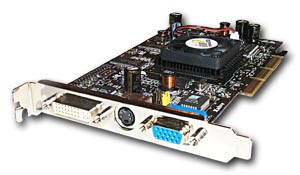 |
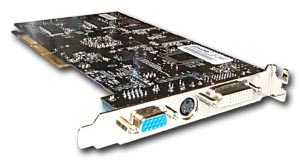 |
| PowerColor Evil Xabre400 | |
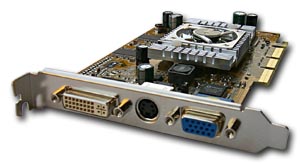 |
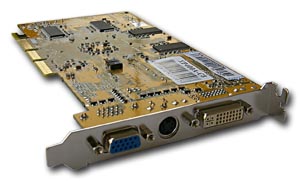 |
| Chaintech Xabre400 | |
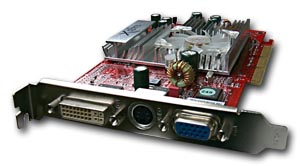 |
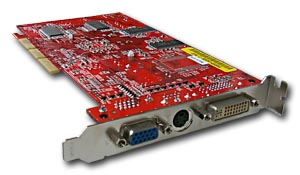 |
| Soltek Xabre400 | |
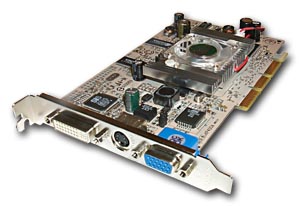 |
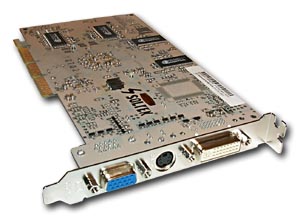 |
| Inno3D Xabre400 | |
| Hynix memory, 4ns access time. The card operates at 250/250 (500) MHz. | 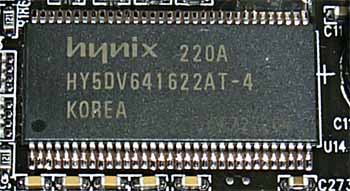 |
| PowerColor Evil Xabre400 | |
| Samsung memory, 4ns access time. The card operates at 250/250 (500) MHz. | 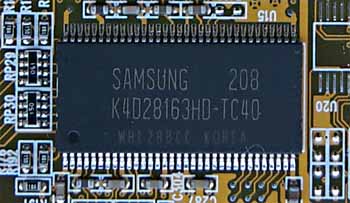 |
| Chaintech Xabre400 | |
| Samsung memory, 4ns access time. The card operates at 250/250 (500) MHz. | 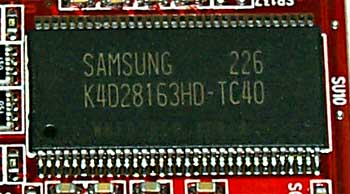 |
| Soltek Xabre400 | |
| EtronTech memory, 3.5ns access time. The card operates at 275/250 (500) MHz. The chip's speed has reached the Xabre600's level, though it's not advertised. | 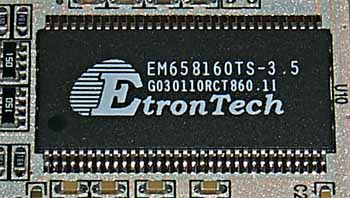 |
| Comparison with the reference design, front view | |
| Inno3D Xabre400 | Reference card SIS Xabre400 |
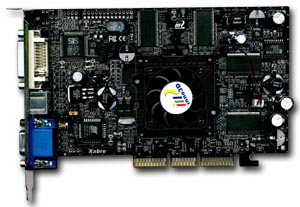 |
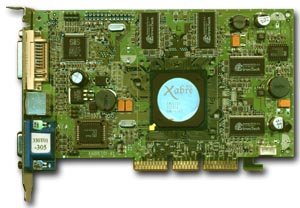 |
| PowerColor Evil Xabre400 | |
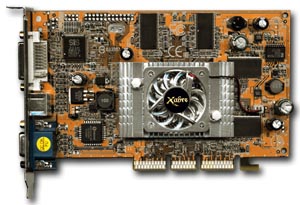 |
|
| Chaintech Xabre400 | |
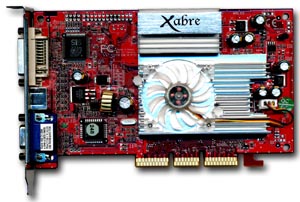 |
|
| Soltek Xabre400 | |
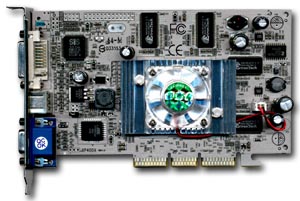 |
|
| Comparison with the reference design, back view | |
| Inno3D Xabre400 | Reference card SIS Xabre400 |
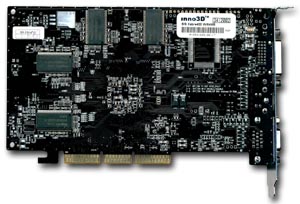 |
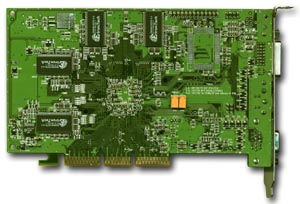 |
| PowerColor Evil Xabre400 | |
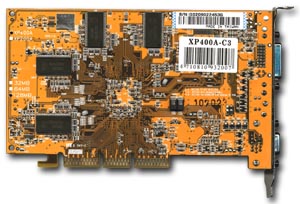 |
|
| Chaintech Xabre400 | |
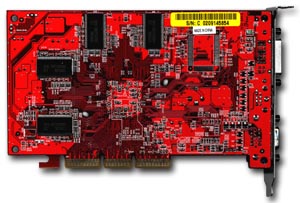 |
|
| Soltek Xabre400 | |
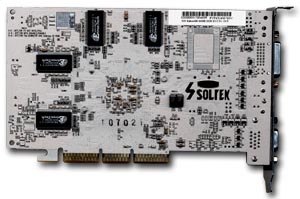 |
|
All the PCBs look similar and the design is almost identical to the reference one. The cards differ only in color and memory size.
However, there is one more interesting point that distinguishes the Soltek's card: its chip works at 275 MHz instead of standard 250. If the memory worked at 275 (550) MHz, we would have a normal Xabre600. However, the chip's increased speed didn't boost up the performance with the memory working at its standard frequency, but it will be touched upon later.
The cards have also different coolers and accessory packs.
Here are the cooling devices:
The coolers are hiding the Xabre400 GPU itself:

As I mentioned lots of times, such cards support TV-out via the SIS 301 coprocessor which is mounted on nearly all Xabre based solutions. TV-out quality is discussed in the first review of the list above.
Now I'm going to take a peep into the boxes.
The video cards ship in retail packages.
That's all about peculiarities of the cards.
| Inno3D Xabre400 | 250/500 -> 275/540 MHz |
| PowerColor Evil Xabre400 | 250/500 -> 273/548 MHz |
| Chaintech Xabre400 | 250/500 -> 280/550 MHz |
| Soltek Xabre400 | 275/500 -> 300/560 MHz |
Look at the Soltek's card: well, the core seems to be doing well, and if the memory had a good potential as well, the core's speed could be much more beneficial.
Attention!

Testbeds:
In the tests we used SiS's drivers of ver.3.06.55. S3TC was off in the applications.
Before we start examining 2D quality I should say that there is no a complete technique of objective estimation of this parameter because:
Now I'm going to estimate operation of the cards in 3D. This part of the tests consists of two subsections. In the first one we will touch upon some aspects of operation of the Xabre in the 3DMark2001:





| 1DMark1913 | 3DMark2001 |
| Game 1 | |
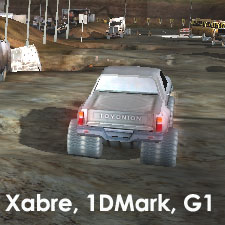 |
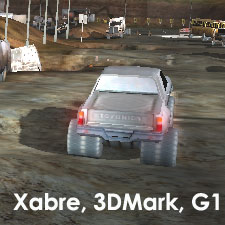 |
 |
|
| Game 3 | |
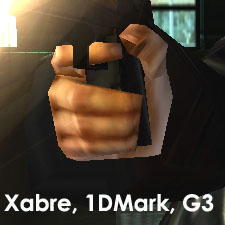 |
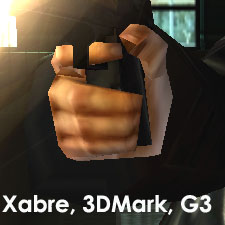 |
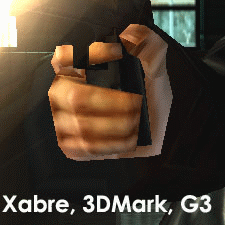 |
|
| Game 4 | |
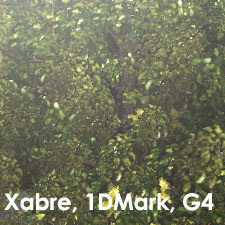 |
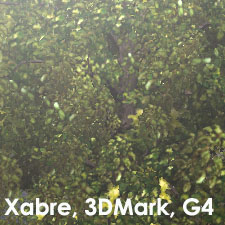 |
 |
|
Although the difference could be unnoticed at fight glance, they play with light (it's well seen in Game4). In the 1DMark1913 the processing is complete, and in the 3DMark2001 the drivers treat the lighting in a specific manner. Hence the speed gain. Note that the tests in the 1DMark1913 were also carried out with the NVIDIA and ATI based cards, but there were no noticeable changes. All the tests were fulfilled in the turbo texturing mode of the Xabre where the pictures have quality inferior to the rivals. What happens when this mode is off is described in the previous article.
When the patch for the 3DMark2001SE was announced (which was meant to improve operation with the Xabre), after the tests on the version 3.30 we wondered why the speed grew up on the same drivers in all the tests of the 3DMark2001SE? And now we can see how easily test packets and drivers can adjust. The history of such optimizations goes back to 1998 when ATI released its turbo drivers for the Rage Pro which marginally increased the performance in the 3D WinBench, and after that the packet started losing its popularity. I'm afraid the MadOnion and its 3DMark can follow it...
And now take a look at the summary diagrams from our 3Digest so that you can have deeper understanding of how such cards perform.
The overclocked cards are marked with red color, the sign o/c (overclocked) is followed by the frequencies reached.
Before we arrive at the final conclusion let's take a look at the prices of the Xabre400 cards: $75 on average. In comparison, the RADEON 9000 is priced at $65, and the RADEON 9000 Pro at $92. The Xabre, being much more efficient, doesn't support anisotropic filtering and vertex shaders (which means a defeat in UT2003-type games), has 3D quality lower than that of other cards (due to turbo texturing), and it's dearer. However, the rumor has it that some Xabre400 solutions are already shipping somewhere at $40 in retail. I assume that at about $50 the Xabre400 based cards will find their market, especially because of the excellent TV-out. But right now, I can't recommend them at $75. Remember that we haven't mentioned yet AA quality (see the next 3Digest, a new section on the AA).
Highs:
Write a comment below. No registration needed!
|
Article navigation: |
| blog comments powered by Disqus |
| Most Popular Reviews | More RSS |
 |
Comparing old, cheap solutions from AMD with new, budget offerings from Intel.
February 1, 2013 · Processor Roundups |
 |
Inno3D GeForce GTX 670 iChill, Inno3D GeForce GTX 660 Ti Graphics Cards A couple of mid-range adapters with original cooling systems.
January 30, 2013 · Video cards: NVIDIA GPUs |
 |
Creative Sound Blaster X-Fi Surround 5.1 An external X-Fi solution in tests.
September 9, 2008 · Sound Cards |
 |
The first worthwhile Piledriver CPU.
September 11, 2012 · Processors: AMD |
 |
Consumed Power, Energy Consumption: Ivy Bridge vs. Sandy Bridge Trying out the new method.
September 18, 2012 · Processors: Intel |
| Latest Reviews | More RSS |
 |
Retested all graphics cards with the new drivers.
Oct 18, 2013 · 3Digests
|
 |
Added new benchmarks: BioShock Infinite and Metro: Last Light.
Sep 06, 2013 · 3Digests
|
 |
Added the test results of NVIDIA GeForce GTX 760 and AMD Radeon HD 7730.
Aug 05, 2013 · 3Digests
|
 |
Gainward GeForce GTX 650 Ti BOOST 2GB Golden Sample Graphics Card An excellent hybrid of GeForce GTX 650 Ti and GeForce GTX 660.
Jun 24, 2013 · Video cards: NVIDIA GPUs
|
 |
Added the test results of NVIDIA GeForce GTX 770/780.
Jun 03, 2013 · 3Digests
|
| Latest News | More RSS |
Platform · Video · Multimedia · Mobile · Other || About us & Privacy policy · Twitter · Facebook
Copyright © Byrds Research & Publishing, Ltd., 1997–2011. All rights reserved.